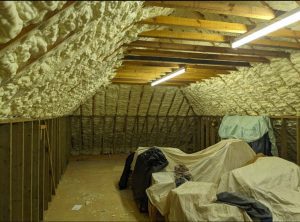Has Spray Foam Insulation Made 250,000 Homes Hard to Sell?
Concerns Over Unqualified Firms Using Incorrect Foam Types, Hindering Home Loans
Spray foam loft insulation is quick to install and promises to reduce energy bills. However, it can create difficulties when re-mortgaging, selling, and unlocking equity release. Lenders are worried that unqualified firms may not be using the correct type of foam, causing these issues.
After their monthly energy bill soared to £500 this year, pensioners Rudi Szczerba and his wife Pat decided to quickly insulate their draughty terrace home.
The timing seemed ideal when a salesman contacted them about a type of loft insulation called spray foam.
Promising a 40 percent reduction in their bills, Rudi, 72, described the decision to install the insulation as a ‘no-brainer’.

The foam was installed in September at a cost of £3,800. If energy bills remain high, they could recoup this expense in less than five years through savings.
This is a decision that around a quarter of a million households have made in the past decade. However, many are unaware that spray foam insulation comes with potential drawbacks.
Due to the unregulated nature of the industry, lenders are increasingly concerned that unqualified firms may not use the correct type of foam or properly assess a property’s suitability.
Consequently, homeowners are finding it difficult to re-mortgage, unlock equity from their homes, or even sell them.
Rudi and Pat’s Discovery
Rudi, 72, and Pat, 75, both retired Polaroid employees, have encountered an unexpected scenario. The couple aimed to release £25,000 in equity from their newly improved £1 million end-of-terrace home in Knebworth, Hertfordshire.
With no children to inherit their property wealth, they planned to gift the money to a lifelong friend in poor health to assist with his finances.
However, their equity release adviser informed them that no lender would approve an equity release loan due to the spray foam insulation. They claim the installer never disclosed this potential issue.
Equity release lifetime mortgages, available to homeowners aged 55 and older, have grown in popularity. According to a trade body, a record £3.1 billion of property wealth was withdrawn in the first half of the year.
These mortgages allow homeowners to obtain a tax-free loan while retaining ownership. The loan is repaid when the home is sold, the borrower dies, or the borrower moves into care. However, homeowners with spray foam insulation are being excluded from the market.
No equity release loan permits spray foam insulation installed after a property’s construction. Only one lender, More2life, will consider it if installed during construction and meeting strict quality criteria.
Mark Gregory, chief executive of Equity Release Supermarket, states, “We think any spray foam installation company should inform homeowners that using spray foam would currently make them ineligible for a lifetime mortgage if they consider equity release.”
Rudi and Pat are among the 250,000 households that have used spray polyurethane foam for insulation. Before the scheme was withdrawn in March 2021, spray foam was eligible for installation under the green homes government grant. It can insulate lofts, roofs, walls, and floors to improve energy efficiency.

Industry Practices and Homeowner Concerns
There is no industry code of practice, and installers are not required to inform homeowners that spray foam insulation could impact their ability to secure a mortgage or equity release.
Lenders worry that some installers may have used the wrong type of foam or failed to verify if it was suitable for the home. This oversight can lead to rotten beams and costly roof replacements. Additionally, there is no straightforward way for a surveyor working for a mortgage lender to inspect the roof timbers after spray foam has been applied, making the home potentially un-mortgageable and unsellable, as Lorna Rolfe discovered.
Lorna paid £5,000 to have foam installed in 2020 after seeing a Facebook advertisement. However, when she tried to sell her home near Dartmoor this summer, the buyer’s bank refused the mortgage after the surveyor noticed the foam insulation in the loft. To prevent the sale from collapsing, Lorna, an occupational therapist, spent £4,000 to have it removed.
“I needed to sell my home to move closer to my 90-year-old uncle who has moved into a care home,” says Lorna. “The whole situation caused me a lot of stress and anxiety. I also found out the foam was flammable, toxic, and sprayed directly onto electrical cables. My life was at risk the whole time.”
Claims management firm Hydrogard Legal Services is handling over 250 claims from vulnerable or elderly homeowners who were targeted by cold-callers and not informed that the foam could hinder their ability to sell their homes.
Rudi and Pat are currently negotiating with a lender willing to review the guarantees provided by their installer. If they are denied, the installer has promised to remove the foam and refund their money.
Kunle Barker, of architect and design studio Barker-Walsh, notes, “If spray polyurethane foam is not installed correctly, it may not provide the right ventilation, which could cause roof timber to rot.” Properly installed spray foam allows the roof to breathe and prevents moisture build-up.
Homeowners are advised to work only with installers who conduct a hydrothermal evaluation, assessing the roof’s condition, the felt underneath, and the risk of condensation. While this documentation improves a homeowner’s chances of selling the property or obtaining equity release, it is not a guarantee.


